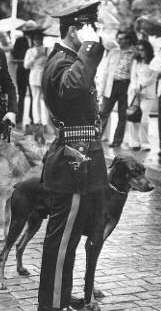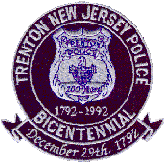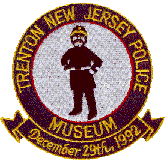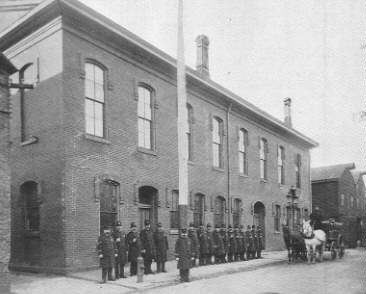TRENTON POLICE MUSEUM

1880 - 1899

Historic Synopsis
1880ís
The 1880ís was a decade during which the Trenton Police Department went through many radical changes. Perhaps no time before, and certainly none after, has had such an impact on the Police Department. It was a period of expansion for Trenton, which like many other cities of the time sought to expand its borders by annexing abutting townships and boroughs. The year 1888 saw Trenton nearly double in size when Millham Township and the Borough of Chambersburg were incorporated into the city. The expansion not only caused Trentonís area to increase, but the Police Department as well. Officers from Millham and Chambersburg were absorbed into the Trenton Police Department.
Unfortunately, it was also a decade in which political influence was extreme and cronyism ran amok. Appointments of Officers had little to do with ability and character. The guiding concerns were the repaying of "political favors" and how many votes the appointee could garner during elections. The most blatant example of the "politics" involving the Police Department occurred in 1881, when the Democrats gained control of the Common Council and immediately removed Charles Thorn from the post of Marshall/Chief and replaced him with Charles McChesney. A month later, the new Common Council replaced the entire Police Department (who were all Republicans) with Democrats. In 1887 when the Republican controlled Common Council attempted the same maneuver, law suits and counter suits were launched, with the Republicans losing. The State Assembly grew tired of the power which politicians had over Police Departments in New Jersey and passed a law requiring the formation of a Police Commission, comprised of two Democrats and two Republicans. In 1889, the citizens of Trenton overwhelmingly voted to accept the legislation.
|
1886 Manpower and Salaries
| Position |
# of Men |
Annual Salary |
| Chief |
1 |
$950 |
| Lieutenants |
2 |
$800 |
| Sergeants |
2 |
$750 |
| Patrolmen |
25 |
$720 |
| TOTALS |
30 |
$22,050 |

1890ís
With the turmoil and expansion of the 1880ís behind it, the Police Department witnessed a stability which it had never experienced before. Chief McChesney was in his ninth year at the helm, with nine years of service still in front of him. The city was divided into two police districts, the First Precinct was the Headquarters for the department and was located in the newly refurbished Freeze Market House on Chancery Lane. The Second Precinct was housed in the old Chambersburg municipal building on South Broad Street, which had previously served as a jail house and needed minor renovations. In 1898, the last major expansion of the city occurred when the Borough of Wilbur was annexed by Trenton. By 1899, the force had grown to 80 men, a full 166% leap from the 30 man force of 1886.
|

Gallery

| Chief Charles H. McChesney |
|---|
|
Appointed as Marshal of the Police Department on April 20, 1881, a position which he held until 1886, when the title of Marshal was changed to Chief of Police. Chief McChesney served as Chief until 1899.
|

| First Precinct, Police Headquarters |
|---|
| circa 1890's |
|
Officers stand at the front of Police Headquarters on Chancery Lane. The former Freeze Market House was converted into the police building in 1888 and served as Headquarters for the department until 1972. There were fourteen cells (10 male, 3 female & 1 "Dungeon" cell for the Insane). Shown in the photo are the officers in their wool over coats and standard helmets. Also depicted is a horse drawn police wagon. The building no longer stands.
|

| First Precinct, Front Desk |
|---|
| circa 1890's |
|
The lobby of the first precinct, complete with gas lamps and spittoons.
|

| First Precinct, Gym |
|---|
| circa 1890's |
|
Outfitted with the most modern of equipment, officers could come here and spend some time on the Rings, Vault and Bicycles or knock the speed bag around some.
|

| William Dettmar |
|---|
| circa 1898 |
|
No other man was more effected by consolidation than William Dettmar. Made a Patrolman of Chambersburg in 1882 and raised to the rank of Chief in 1886, Dettmar was made an "acting" sergeant of the Trenton Police Department in 1888. It was thirty years before he became Chief again, a position he held from 1918-1922.
|

| Second Precinct |
|---|
| circa 1898 |
|
Built in the early 1880's as the municipal building for Chambersburg, it also housed the Chambersburg jail and Police Department. After consolidation in 1888, renovations were made and additional cells were built. The building, which stands to this day, served as the Second Precinct until 1972.
|

| Second Precinct, Front Desk |
|---|
| circa 1898 |
|
The lobby of the Second Precinct, lit by gas lamps and having a well crafted wooden desk and railings. The "Blotter Book" (or Incident Book) which is most likely sitting on the desk at the time of this picture is on display at the Trenton Police Museum.
|

Personnel

| Manpower, 1898 |
First
Precinct |
Second
Precinct |
| Chief |
1 |
O |
| Captains |
1 |
1 |
| Sergeants |
3 |
3 |
| Detectives |
2 |
O |
| Roundsmen |
2 |
2 |
| Chancemen |
1 |
O |
| Patrolmen |
32 |
28 |
| Surgeon |
1 |
O |
| Superintendent of Telegraph |
1 |
O |
| TOTAL=80 |
46 |
34 |

| CHIEF |
|---|
| circa 1898 |
|
Stationed in the First Precinct, Chief McChesney sits in his office.
The Chief was responsible for the overall operation of the department and making timely reports to the Mayor and Police Commission.
|

| CAPTAINS |
|---|
| circa 1898 |
|
Captain John J. Cleary, of the First Precinct wearing the uniform of the day. The Captains were in charge of the Precinct-houses and responsible for their cleanliness, good order and condition. They also examined the Docket to ensure all entries were accurate and signed their name in approval.
|

circa 1898
Roundsmen James Mullen & Phineas Randolph (top, L-R) |
Sergeant Andrew Sweeney (middle) |
Roundsmen Cornelious McNamara & John W. Zenker (bottom, L-R) |
Commissioner Richard R. Lutes (bottom, center)
|
| SERGEANTS |
|---|
|
The Sergeants were required to always be present in the station-house and to have general charge of the Patrolmen on their beats. They were also responsible for the general good order and discipline of the force.
|
| ROUNDSMEN |
|---|
|
Roundsmen were responsible for making inspections of the officers before roll call and ensuring the beat officers were diligent in there duties. They were to visit as many beats as possible in a shift and to approach from a direction not expected. The Roundsmen also delivered orders to the beat officers.
|

| PATROL WAGON DRIVERS |
|---|
| Allan Rogers & Wesley Wooley |
| circa 1898 |
|
The Patrol Wagon service was first established on December 14, 1887 and the
Drivers were responsible for the cleanliness and care of the horses, wagons, harnesses and stables. Working in alternating 12 hour shifts, they were responsible for transporting prisoners and drunks as well as performing ambulance duties. In 1898, the Wagon Service handled 237 ambulance calls, 908 Patrol Service calls and transported 1066 prisoners.
|

 |
| PATROLMEN |
|---|
| Augustus F. Kulp, Edward Caughlin, Edward Kelly |
| circa 1898 |
|
In 1899 there were 60 Patrolman on the department, with the overwhelming majority working foot patrol. The area they patrolled was known as their "Beat". The routes they patrolled were predetermined and any deviation from this route required an explanation. The officers were required to report to the precinct house using "Call boxes" at specific times. A few of the early call boxes had telephones, however most used a telegraph. If the officer made an arrest he would have to escort the suspect to a Call Box, where he would call for a Patrol Wagon. In times of emergency the officers would blow their whistle or strike their night sticks on the pavement, alerting nearby officers of their need. The requirements for becoming a Patrolman included: good moral character; no less than 5'7" tall; between 150-200 pounds. Additionally, the applicant must be able to read and write English. Schooling had little to do with being hired. (One man who ascended through the ranks to Chief, had only a 6th grade education.)
|

| CHANCEMEN |
|---|
| Chancemen were newly appointed Patrolman who served for six months as temporary officers. The men were paid $50 a month and after the six months, if they had proven themselves duly qualified for the position, they were made Patrolmen at regular pay.
|

| Mounted Patrol |
|---|
| circa 1880's |
|
The identity of this officer is not known, however he is likely a Roundsman. The area Roundsmen were required to cover necessitated the use of horses.
|

Detective Bureau

| Detective Sergeant Charles Pilger |
|---|
| circa 1898 |
|
On December 19, 1888, Officer Pilger was made a "Special Officer in Civilian Dress" a title which was later changed to Detective, when the position was formally created on February 26, 1891. Pilger and Henry Leahy were the first detectives of the department, whose duties included being present at public gatherings, tracking convicted criminals and investigating major crimes.
|

| Detective Sergeant Libson R. Applegate |
|---|
| circa 1898 |
|
Detective Applegate rounded out the Detective Bureau in 1899. Applegate along with Pilger answered directly to the Chief. Stationed in the First Precinct, they discharged their duties in both districts.
|

| The Rogues' Gallery |
|---|
| circa 1898 |
|
Detective Pilger sits at his desk, while the cabinet containing the Rogues' Gallery stands in the background. One of the primary duties of the Detectives was to "mug" (photograph) prisoners for identification. This collection of Mug Shots was known as the Rogues' Gallery.
|

1898 POLICE BUDGET
| ITEM |
AMOUNT
BUDGETED |
| Salaries (80) |
$60,022.72 |
| Station-houses |
3,803.46 |
| Police Telegraph |
1,954.93 |
| Patrol |
1,410.96 |
| Printing/Stationary |
422.22 |
| Clothing |
1,925.71 |
| TOTAL |
$69,540.00 |

| Chief Judson Hiner |
|---|
| circa 1910 |
|
As the 1800's grew to a close, so did the era of Chief McChesney, who commanded the department for 18 years. In 1899, Judson Hiner was raised to the rank of Chief and had the honor of ushering in the new century.
|

Table of Contents
[ MUSEUM HOME PAGE |
DEPARTMENT HOME PAGE ]
Persons have ANY materials relating to the history of the
Trenton Police Department, are requested to Click Here.
Direct questions or comments to historian@tpdhistory.com
©1997, 1998, 1999, 2000, 2001, 2002, 2003 by M. Crosby Click here for more copyright information Click here for more copyright information
|


















